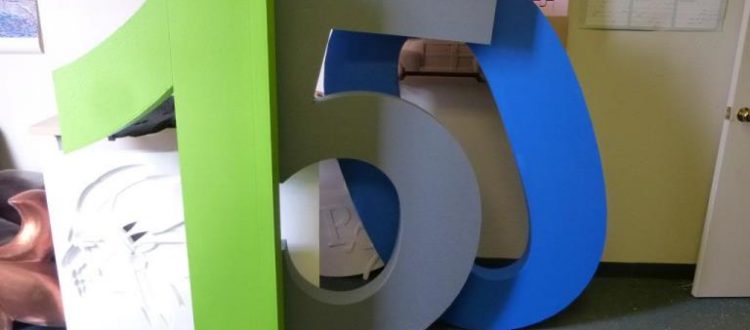If you are into sign making using dimensional lettering, then this is for you. I will give some pointers on the process of repainting a sign with plastic lettering.
Question: I have an outdoor sign that has recessed plastic lettering. Is there a simple way to protect the letters so that I can spray paint the sign?
Also, it would be ideal if it were easy to remove the protective covering or coating once the sign is painted.
Probably the best way to protect the plastic lettering is to use a painter’s masking tape and some light-weight plastic sheeting similar to what is used for painting an automobile.
1. Clean the edges of the sign letters.
First, you’ll want to make sure the edges of the letters are clean and free of oil, dirt, or debris, just like you would with pretty much any other item like a window on your home or car, so that the painter’s tape will stick well to the lettering and not blow off with the force of an airless sprayer.
2. Tape down all of the flapping plastic.
With this light-weight plastic sheeting, you’ll also want to make sure all flapping plastic is taped down as well or it may be loose enough to flap into your lovely, smooth and wet paint, thus messing up what should have been an easy spray painting job.
3. Choose the right paint coating for the lettering.
 The right paint for your project will depend on what you’re painting. If you’re painting over a painted surface, it is best to know what was painted initially, but for the most part, different types of paint are usable over other types of paint, although it would be terribly wise of you to test an obscure corner if you don’t know what was used on the initial painting of the sign cabinet or board.
The right paint for your project will depend on what you’re painting. If you’re painting over a painted surface, it is best to know what was painted initially, but for the most part, different types of paint are usable over other types of paint, although it would be terribly wise of you to test an obscure corner if you don’t know what was used on the initial painting of the sign cabinet or board.
If latex or oil-based paints were used, you should be able to use either/or latex or oil-base paint or acrylic. If you’re painting a metal cabinet, it’s likely that an acrylic-based paint was used, or an automotive type of paint. Most paints will adhere to this paint if it has chalked off. It should be cleaned, lightly sanded, and brushed off again before applying a new coat of paint.
I would generally advise against latex paints in this usage, though, as they tend to expand and contract in the weather at a slower rate than metal does (if you’re painting a metal sign) and seem, in our experience, to flake off the sign faster than most paints will. Again, though, it is always best if you take the time to test the new paint on the original paint, even if you know what was used.
4. Apply a second coating.
It may be necessary to put a 2nd coat on when spraying as well. You cannot paint too heavily on a vertical surface, or your paint will possibly run. It is better to put down a thin coat, let it dry, then apply a 2nd coat. It might be a good idea to make sure it isn’t going to rain or snow any time soon, as you may feel pressured to rush the project, which never bodes well, in our experience.
5. Wait for the paint to completely dry before removing the plastic film.
After you’ve painted your sign cabinet or background, wait until the paint is completely dry to remove the plastic film, usually at least 24 hours. The reason for this is that if you pull the plastic and tape too early, paint will flake off your plastic sheeting and painter’s tape, and fall onto the still tacky paint, once again messing up your beautiful paint job.
So, it is always key, in our experience, to plan well and take your time. You cannot rush any job that has paint involved or you run the risk of painting more than once, which will, of course, than just taking the right amount of time the first time around.
In Conclusion
I know that the above is true because I am world’s least patient person, and I’ve done many jobs twice or more times in my life because of it. Now that I’m in my 50’s, I’d like to think I am more patient than I was in my 30’s or 40’s, but I don’t have to paint all that much any more, so I don’t get to test this these days to tell you if it’s true or not. But at least I know what not to do, and hopefully you’ll learn from my impatient ways.
Popular Posts:




